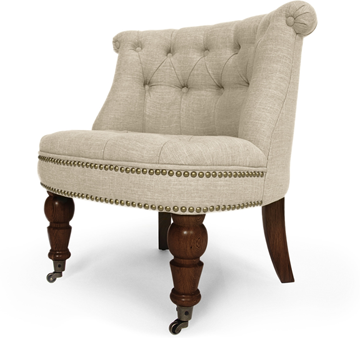
| Volume 31 #3 | November/December 2014 | |

An amazing thing.
I attended a workshop recently, and you can picture the scene: though we
were in the sets the Teacher had asked for, we were still greeting friends
from near and far that we hadn't seen since the last workshop or longer,
whispering, laughing, hugging -- very much partaking of the "social" part
of that oft-quoted
definition of Scottish Country Dancing as the "social dancing of
Scotland" -- and, alas, the Teacher could not be heard.
Sigh, yes, we've all been there before. What happens next is not quite so social, as either the Branch Representative takes it upon herself austerely to "shush" the hall, or the Teacher breaks stride to "shush" the hall, or perhaps worse, folds her arms and passively waits, and waits, until the talkers lapse into embarrassed silence. What is a Teacher to do?
But at this workshop I attended, an amazing thing happened: someone, somewhere in the hall, began making a long "shshshsh" sound, without looking at anyone, just loud enough for her partner to hear it. But someone else did hear it, and took it up -- a low "shshshsh" sound not terribly loud, and not directed at anyone, and then others took it up... I would say, within three seconds the hall was absolutely still but for the Teacher, who carried on as if nothing had happened. It was quick, simple, and no-one was embarrassed or inconvenienced.
What if, at the beginning of a class, a small group of aficianados -- intermediates? teachers? teacher spouses? -- with a wink, formed an "Impromptu Shsh Committee". Whenever the noise gets out of hand, hopefully some one of them will think to look at the floor and whisper "shshsh", and if you hear that "shshsh", try to take it up and do the same. It could be amazing!
'Tis the Season!
Thanksgiving, Christmas, New Years'
As we know, this is a great time of year for dancing! The weather is
deliberately cooling off in support of better technique,
and there is a
plethora, ahem, of workshops, monthly dance parties, classes for all
levels, and Balls springing up all over the place, up and down the coast and
into Canada. Many of these events are,
for us, out of the
area, providing even more opportunities for sharing the dancing joy, in the
form of road-trips, car-pooling, and
"hospitality" (that overnight boarding of Traveling Dancers by dancers
local to the event) -- all wonderful ways to meet new dancing friends.
So, what kind of events would you like our Branch to put on? Given the large size of the Vancouver/Portland metropolitan area, what do you think is possible? Think of the enjoyable events you've been to, the teachers, the dance bands; how would we like to do something like that here? And, for those not yet familiar with these great events, what can we do to "get them hooked"? In Scottish Country Dancing, "happiness" loves company!
The third weekend in October, Tom and I joined a highway full of Oregon Ducks in a migration to Eugene. While the folks with "O's" on their vehicles headed for the stadium, we headed for the Veterans' Memorial Ballroom to join The Heather and the Rose Country Dancers for their yearly Harvest Ball. A much-needed afternoon ball walk-through helped Tom and I learn those unfamiliar English Country dances and Chuck Ryer's fun whiskey-themed Scottish Country Dances.
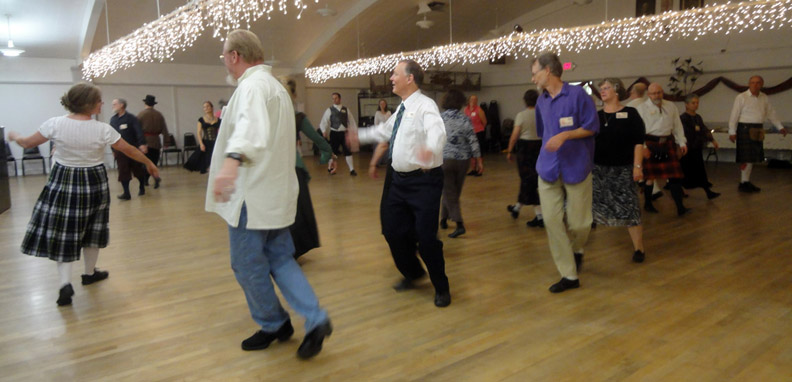
The ball was quite enjoyable, with new friends and old, and lovely music provided by D 'n' A. It was nice to see some of the folks who come to our dances, like Robert Burger, Laurel Olivolo and David Sullivan, and Susan and Max Leek. The break-time snack spread was fantastic. Decorations featured a marvelous tree full of origami crows made by Leslie Wolf. While I remain passionate about Scottish Country Dance, I find that I am less tired at the end of an evening that is a mixture of Scottish and English Country Dance.
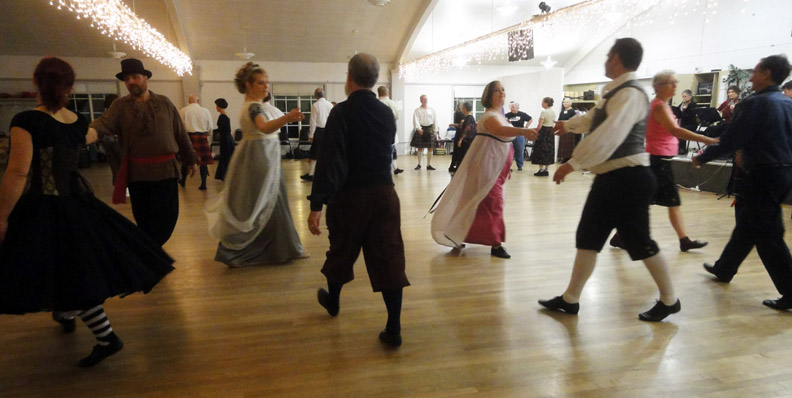
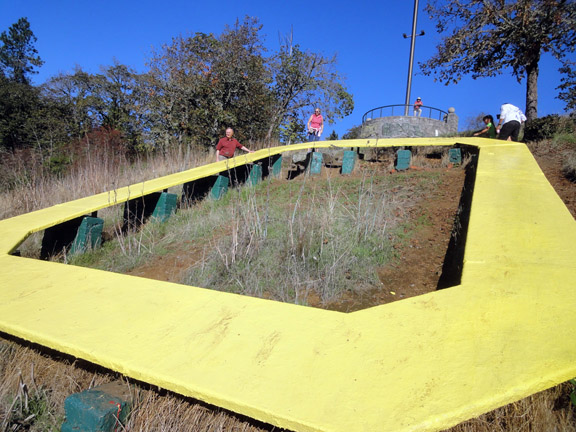
Susan and Max hosted us for the weekend, providing cozy shelter, sparkling conversation, delicious vegetable soup, and a sure-to-become-a-fad breakfast of bread pudding with bacon on top. We introduced them to Tom's new dance figure, the arandel. They introduced us to their more-inclusive version of Catch the Wind, titled Break the Wind. Sunday morning we went for a sunny walking tour of Skinner Butte Park, with its panoramic view of Eugene from atop the University of Oregon "O."
So, we began and ended our trip with an "O," which is emblematic of the circle of friendship. And the weekend was indeed full of the warmth of dancers enjoying each otherís friendship. What could be better?
Letís explore the Fun of "Friendship, Fun, and Fitness" factors that attract people to our dancing activity. I have tried several folk dance forms, and the common theme that appeals to both the thinking and feeling parts of the brain is "move to the music".
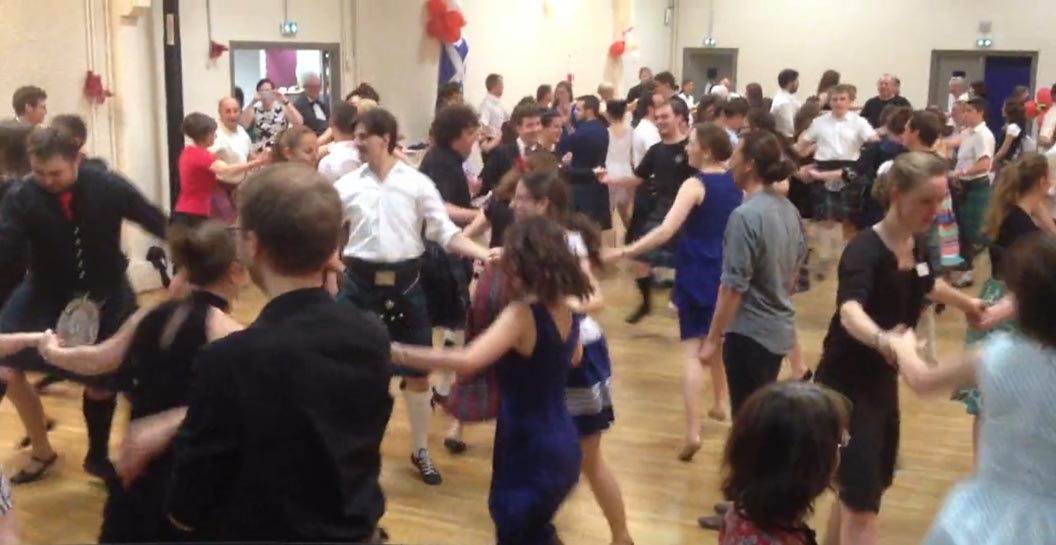
When we photograph dancing as a promotion method, a main goal is to show dancers having fun while moving to the music. Still photos are limiting because they communicate neither motion nor music. A new person might respond differently to a dance photo, compared with an experienced dancer. An experienced dancer can view the photo and imagine what the dancing motion with music is like, based on their experience, while a new person might receive a lower-impact message. A video resonates with the feeling part of the brain where the decision is made to try dancing.
For example, we can improve on this photo of the 2014 RSCDS Spring Fling event of youth Scottish country dancers, with the video that communicates the high-energy motion and music. https://www.facebook.com/deilamangthetailors">Luke Houriet Bradley
We can observe the room of Contra dancers moving energetically to the music. The caller reminds dancers of each figure at the beginning while the music plays a background rhythm. The calling gradually diminishes as dancers remember the pattern, and the musical melody moves to a higher level as dancers enjoy the music while dancing without the caller. https://www.youtube.com/watch?v=KevQxr-saFw
A high-energy Square dance video shows the caller singing a popular song in Germany, and the dancers are singing along. Interesting to listen how the caller mixes calls in English with song lyrics in German. https://www.youtube.com/watch?v=VqLEkqmdEP8
An English country dance video communicates the graceful choreography to the beautiful waltz music. While the caller teaches the figures before beginning the dance, the musicians play along with the teaching tempo, which activates the thinking and feeling parts of the brain. https://www.youtube.com/watch?v=asHd_CY2ZF8
The final video is a medley of Irish Ceili dances with live Irish music. The caller likes to form sets and begin the dance with little instruction. He calls the figures during the dance and relies on experienced dancers to help new dancers learn with fully activated thinking and feeling parts of the brain. https://www.youtube.com/watch?v=Y15mPo8Px_M
Dance groups can attract more people to the Fun of dancing if we focus on moving to the music in all our processes. Move to the music!
A picture is worth a thousand words.
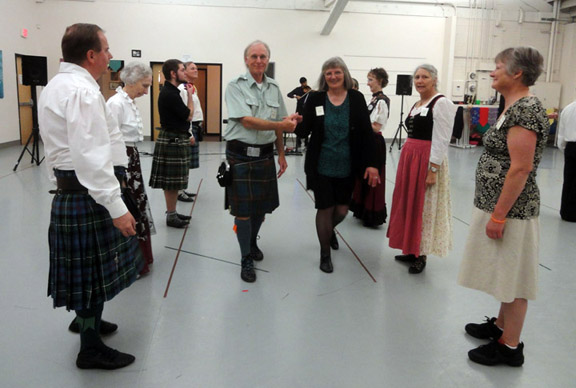
|
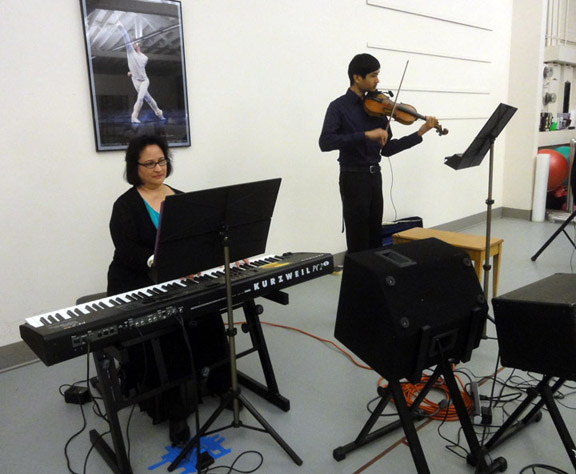
|
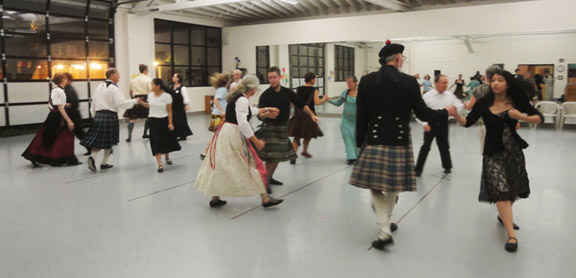
|
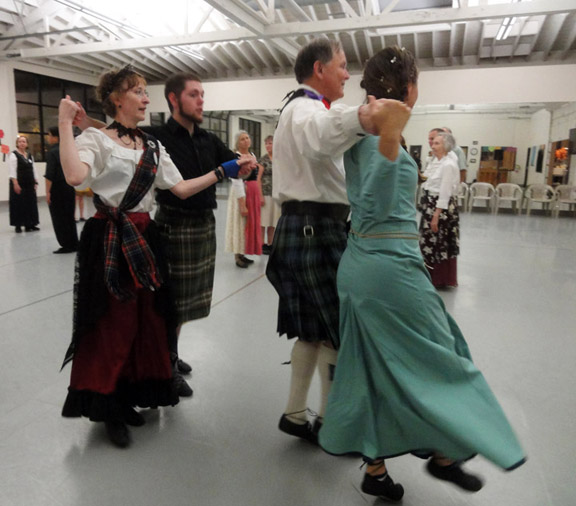
|
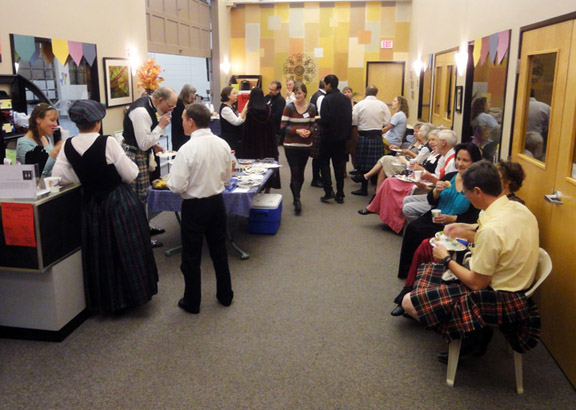
|
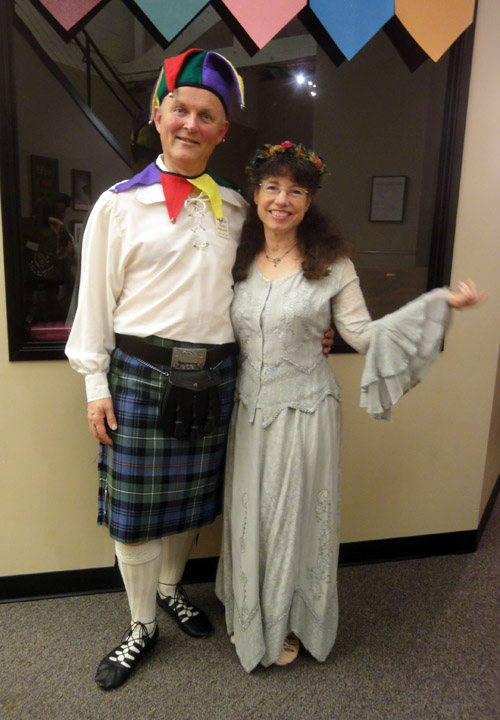
|
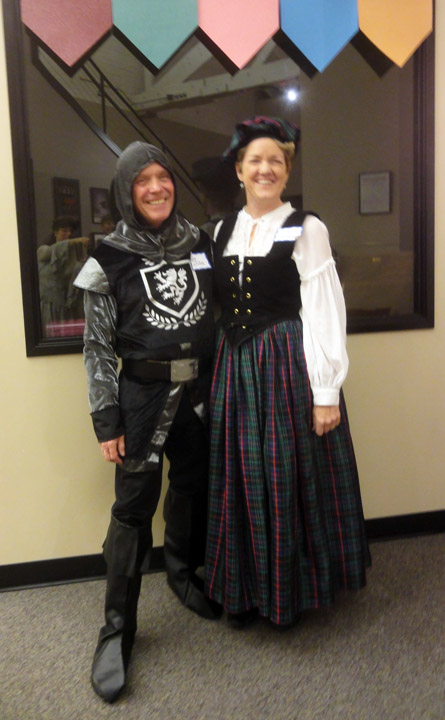
|
On August 2 of this year my two sisters and I boarded a train out of Kingís Cross station in London. Our destination was Aviemore, Scotland. After several days experiencing the bustle and noise of London, we were all ready for the quiet of a small town nestled in Scotlandís largest national park, Cairngorms. In the winter, Aviemore is a ski destination. In the summer, many people come to golf, walk, bike, or climb and experience the Highland culture.
What we discovered was an amazing amount of walking paths supported by public transportation. The towns to the north are fairly close to each other and are connected by a continual path called the Speyside Way (sounds like a dance.) Beyond that, each town has its own set of walking paths that typically circumnavigate the town.
One of our favorite walks was the Wildcat Trail in the town of Newtonmore. We traveled to the town by a double decker bus, stopping first for a tour of the Highland Museum just outside of town. The outdoor museum was chock-full of displays of highland farming life in the 1920's and 30's. In another section after walking through a pine woods were examples of highland life in the 1800's. People dressed in period clothing were interspersed throughout, interpreting the displays.
The Wildcat Trail follows the River Spey then climbs up above and back into the town. Along the trail we found decorated ceramic cats. Apparently, there are over one hundred along the trail and in the gardens of homes. The real wild cat is elusive so it was great fun to spot the ceramic cats. The path meanders gently through moor and woodland sometimes crossing private property. No one is too concerned as Scotland has a right to roam law. This means as I understand it that you can walk anywhere as long as you do no harm to the property you are crossing. We finished our walk just in time to catch the bus back to Aviemore.
Our week in the Cairngorms was delightful. There was so much to do and fairly easy to get around by foot and public transport. The weather was always changing...sun, rain, wind. The people of the Highlands were friendly and always helpful. Our next stop was the Isle of Skye. The adventure continues in the next newsletter.
|
|
|
|
|
|
|
I enjoyed reading Chris Ronaldís Overheard On the Web article in the October 2014 Scottish Country Dancer magazine. Regarding the Gender-free dances and Men dancing on the ladies' side, and vice-versa topics, Liza and I recently attended the Heather and Rose workshop and ball in Eugene Oregon. The dance events are a combination two-thirds English country dances and one-third Scottish country dances. http://heatherandrose.org/
The group has an inclusive gender-free dancing philosophy with global terminology. http://heatherandrose.org/about.shtml
This web page explains the terminology in more detail. For example, Left File is the Man side and Right File is the Woman side. Liza was the guest SCD teacher for the group's dance camp, and she needed to figure out how to teach the Scottish dances with global terminology. http://heatherandrose.org/terms.shtml
I liked forming sets by standing individually on either the right file or left file and observing who arrived as my partner. My brain was working more in order to dance the right-file side. Familiar Scottish dances became a little different as I needed to focus more on where my corners are, etc. SCD teacher Chuck Ryer encourages switching sides because it improves mastery to be able to see the pattern from all perspectives. Extra work also helps keep the aging brain sharp, a primary need for many of us.
I observed another subtle difference with the English country dances in "improper" sets: there is no need for couples to change sides when they progress to the bottom or top of a set. The partners simply change roles as they resume dancing cycles of the dance in the opposite direction.
I get the impression there is a certain degree of social isolation between RSCDS branches and Heather and Rose dance activities. H&R started around 1981, yet there is very little contact with the nearest Portland or Southwest Washington State branches, except for H&R's certificated RSCDS teacher and two couples who attend the Portland and Vancouver dance events. I have observed a psychological block with all folk dance forms, as experienced dancers in a group become unwilling to try an unfamiliar dance form. H&R is unusual because they dance both ECD and SCD. Active reciprocity with Heather and Rose dances has the potential to make new friends and improve participation in our dances, and is a method for the Southwest Washington State Branchís important To-Be List goal: "Be inclusive of everyone who is interested in learning Scottish Country dancing, performing dancing, teaching, devising dances, and/or playing music."
This yearís Kelso Highlander Festival on September 13-14 featured Sally Bledsoe teaching some fun audience participation dances to enthusiastic volunteers. Her able assistants were Tom and Liza Halpenny and Patrick Hogan. Before and after dancing we enjoyed the music of Men of Worth, the athletic games, and shopping at the booths at this nice, low-key family festival in the shady park.
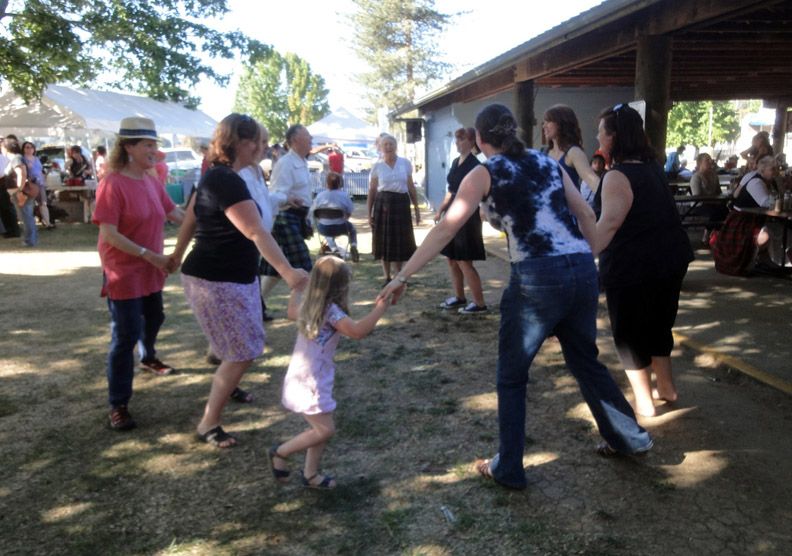
The Royal Scottish Country Dance Society elects its Management Board and committees from members of its 160 branches worldwide, at the Annual General Meeting in November. Since I have an interest in dance group processes, I would like to learn more about the processes of the Society. I submitted my name in nomination for one of the seven open Management Board positions. I would like to thank many of you supporters who signed my nomination petition. I submitted a candidate profile with my SCD background and what I would like to bring to the position. https://www.rscds.org/document/608 I was pleased to learn on September 26 that I have automatically been "elected" for a three-year term, since only three candidates had submitted their nomination. I will be one of the trustees with the responsibility to manage the Society with its annual budget of 800K pounds.
Branches recently received the RSCDS 2013 AGM Minutes, and I enjoyed reading the informative content. https://www.rscds.org/document/703 Branches are enthusiastic about supporting the society activities. Committee volunteers collaborate with the paid staff in order to produce products and services that benefit Scottish country dancers worldwide. I observed a theme with a desire to establish improved communication and partnership with branches. I will be interested to learn which ideas were tried this year, and the results? Branches expressed a desire to continue to improve efficiency and manage costs. I wonder how well aligned HQ and branches' goals are?
Declining membership is a headwind and the greatest perceived risk to the Society's future. Branches are responsible for generating members, and HQ would like to be helpful to recruit members. I recently obtained the membership numbers going back to the beginning. I compared RSCDS membership data with the attendance to the USA National Square Dance Convention 1952-2013. http://www.nsdcnec.com/index.php/nsdc-conventions/past-conventions We observe similar trends when we overlay the charts of the two data sets. The most significant thing I learned from the comparison is that the dominant trends in RSCDS membership and square dance participation are correlated and are global and are challenging to influence. We would want to focus on methods that generate a longer-term membership increase. Which methods have an international effectiveness and can be adapted for different cultures? Which methods depend on local personalities compared with publicity that has a global reach?
It is possible for a branch to locally counteract the globally declining membership trend. Successful branches can share their improvement experiences. However branches are generally isolated from each other. HQ hosted Branch Secretaries workshops in 2012 and 2013 at 12 Coates Crescent in Edinburgh. I am interested in a project to create a new internet Facebook discussion group which is effectively an ongoing Branch Secretaries workshop with worldwide participation. The aim of the group is to examine the role of Branch Secretaries and is intended for current Secretaries and those who may be interested in taking on the role. It is an opportunity for Branch Secretaries to meet each other and network to learn what is going on in the wider environment. HQ might similarly establish Facebook discussion groups for branches to network in other ways.
I am excited to meet the RSCDS Board and committees members and collaborate and learn RSCDS processes. We will hopefully have significant progress to report over the next three years.
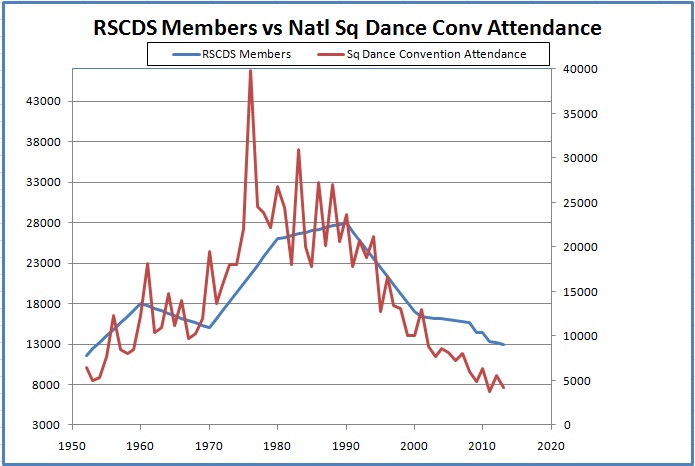
Scottish dance friends performed two days for the Hood Canal Highland Celtic Festival in Belfair State Park on August 30-31, and the group lodged and explored in the nearby harbor city of Bremerton. Liza and Tom Halpenny, Eunice and Martin MacKenzie, Susan and John Shaw, Linda Mae Dennis and Patrick Hogan, Holly Gibson, and Sally Palmer combined the festival performances with a relaxing road trip. We can access the photo album at https://www.facebook.com/media/set/?set=a.824541360901378.1073741831.141476192541235
We needed to mop the water from the stage before dancing the first day. We performed a different program for the second performance on a beautiful sunny and dry day. Here we are dancing St Andrew's Fair. https://www.youtube.com/watch?v=EbOdQcZ8MQE
The Plateau Scottish Country Dancers from Enumclaw also performed. The group leaders Jim and Pat McDonald have our Branch's Feast of Dances book and they like dancing Folksy Fivesome. Dancer Mary Bartley also dances with the Pi-R-Squares and Spinners square dance clubs.
We enjoyed exploring the natural surroundings of Belfair State Park before the performances, and playing games in the evening at the hotel. We separated into two groups and walked around Bremerton. Some members hiked a loop that crossed two bridges while the others explored a ship in the harbor. Everyone rendezvoused at the Blackberry Festival on the Bremerton docks.
After the final performance, the dance group began the drive home in two cars, departing at different times. We coincidentally arrived at the same restaurant for lunch, where they served delicious clam chowder. We resumed the drive home to end a pleasant road trip combining dancing and touring.
Calendar of Events | ||||||||||||
|
|